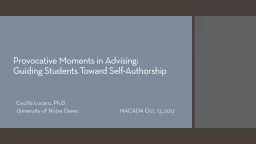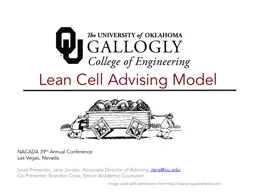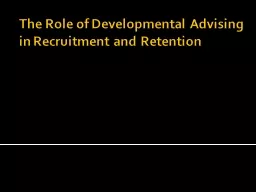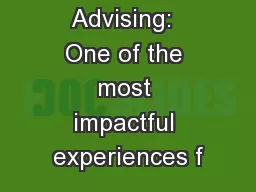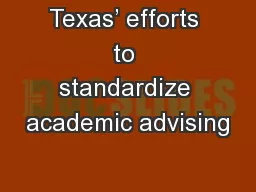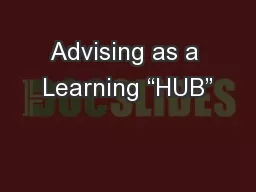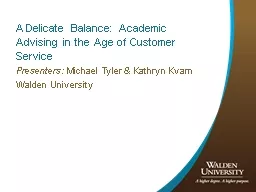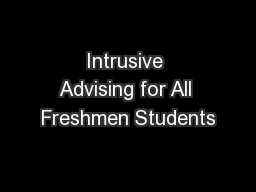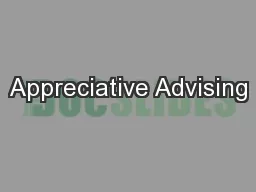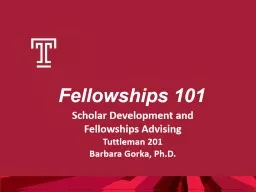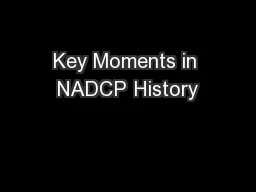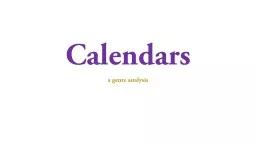PPT-Provocative Moments in Advising:
Author : lois-ondreau | Published Date : 2018-03-15
Guiding Students Toward SelfAuthorship Cecilia Lucero PhD University of Notre Dame NACADA Oct 13 2017 Session Objectives Consider the question What is the advisors
Presentation Embed Code
Download Presentation
Download Presentation The PPT/PDF document "Provocative Moments in Advising:" is the property of its rightful owner. Permission is granted to download and print the materials on this website for personal, non-commercial use only, and to display it on your personal computer provided you do not modify the materials and that you retain all copyright notices contained in the materials. By downloading content from our website, you accept the terms of this agreement.
Provocative Moments in Advising:: Transcript
Guiding Students Toward SelfAuthorship Cecilia Lucero PhD University of Notre Dame NACADA Oct 13 2017 Session Objectives Consider the question What is the advisors role in creating provocative moments regarding topics centered on raceethnicity gender. By:. Stephen Yoo. Michael Vorobyov. Moments. In general, moments describe numeric quantities at some distance from a reference point or axis. . Regular (Cartesian) Moments. A regular moment . has the form of projection . NACADA 39. th. Annual Conference. Las Vegas, Nevada. Lead Presenter, Jana Jacobs, Associate Director of Advising . Jana@ou.edu. . Co-Presenter, Brandon Crow, Senior Academic Counselor. Image used with permission from http://. Developmental . vs. Prescriptive Advising. Prescriptive Advising: What we were used to when we went to college. Here is a list of courses that are required for the major (and minor), here is a list of the number of credits and the categories needed for general education distributions and here is a list of other requirements.. How would you describe your experience?. Academic Advising . 1.7 General Catalog. Academic advising is a relationship with mutual responsibilities between an adviser and student advisee, for timely consultation, sharing of accurate and complete information, careful listening, critical evaluation, and respectful interchange. Academic advising can be facilitated by a professional staff person or a faculty member. . And What You Should Know to Stay Ahead of the Curve. Presented by. De Juana “De J.” . Lozada. . Texas Higher Education Journal. September 2012. FUNCTION. Academic Advising Structures. Faculty. Professional Staff. Interactive Workshop. CACUSS 2015 . Facilitated by Dr. Linda . Pardy. Linda.pardy@ufv.ca. T @. lindapardygroup. 1. .. . Review . current trends. 2. . Assess. the role of advising as a learning hub. Presenters: . Michael Tyler & Kathryn Kvam. Walden University. Walden University. US-based, on-line, for-profit university. Primarily doctoral-level student population. Strong emphasis on business and education programs. Presented By . Tracene Marshall. Senior Academic Advisor. University of Minnesota. College of Food Agricultural and Natural Resource Sciences. My Premises Are:. . All . traditional freshmen . - . not just . A “Flipping” New Model: Orienting and Advising Incoming Students in the New ERA. University College Academic Advising & Orientation. Who Are We?. Don Presnell, Ed.D.. Associate Director of University College Academic . Presented by: Keri Lobdell . TRIO SSS Retention Specialist – WSU Tri-Cities. Learning outcomes: . 1.) Intro to Appreciative Advising – six stages it involves. 2.) Take away ideas to implement Appreciative Advising in your practice. Tuttleman. 201. Barbara Gorka, Ph.D.. Guidance to help students identify and apply for competitive, merit-based awards. Support . in developing application . materials, especially personal statements and other essays. . DUI and Other Treatment Dockets:. “Best Practices, . Best Resu. lts. ”. Terrence D. Walton, MSW, CSAC. Chief . Operating Officer. . National Association of Drug Court Professionals. Key Moments in NADCP History. By:. Michael Vorobyov. Moments. In . general, moments are quantitative values that describe a distribution by raising the components to different powers. Regular (Cartesian) Moments. A regular moment . Art; Video Game. Setting: . . Calendars appear everywhere! Of course they predominantly come into play at the end and beginning of a calendar year (I even had to use the word calendar to define the time period I’m talking about…).
Download Document
Here is the link to download the presentation.
"Provocative Moments in Advising:"The content belongs to its owner. You may download and print it for personal use, without modification, and keep all copyright notices. By downloading, you agree to these terms.
Related Documents

